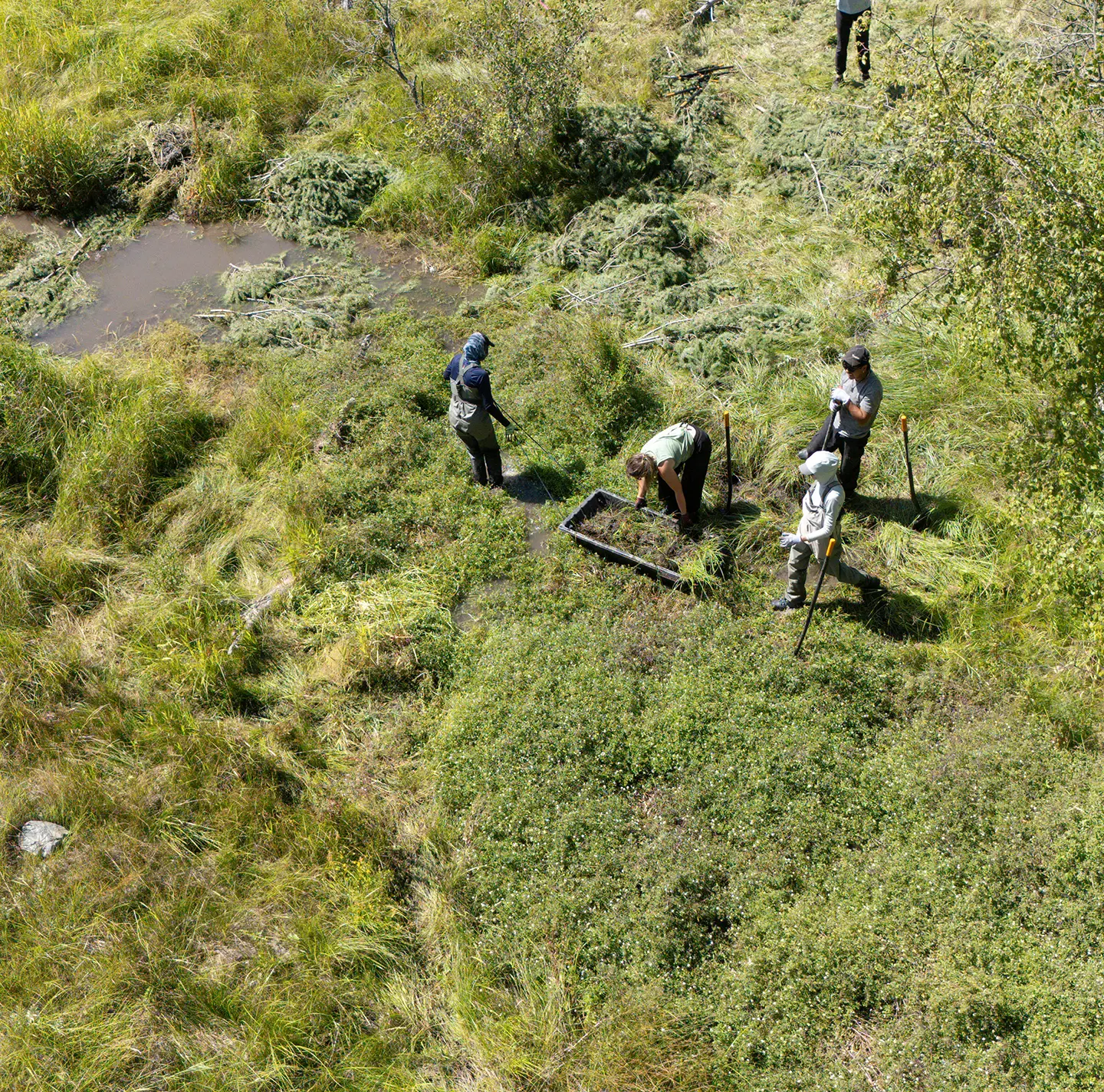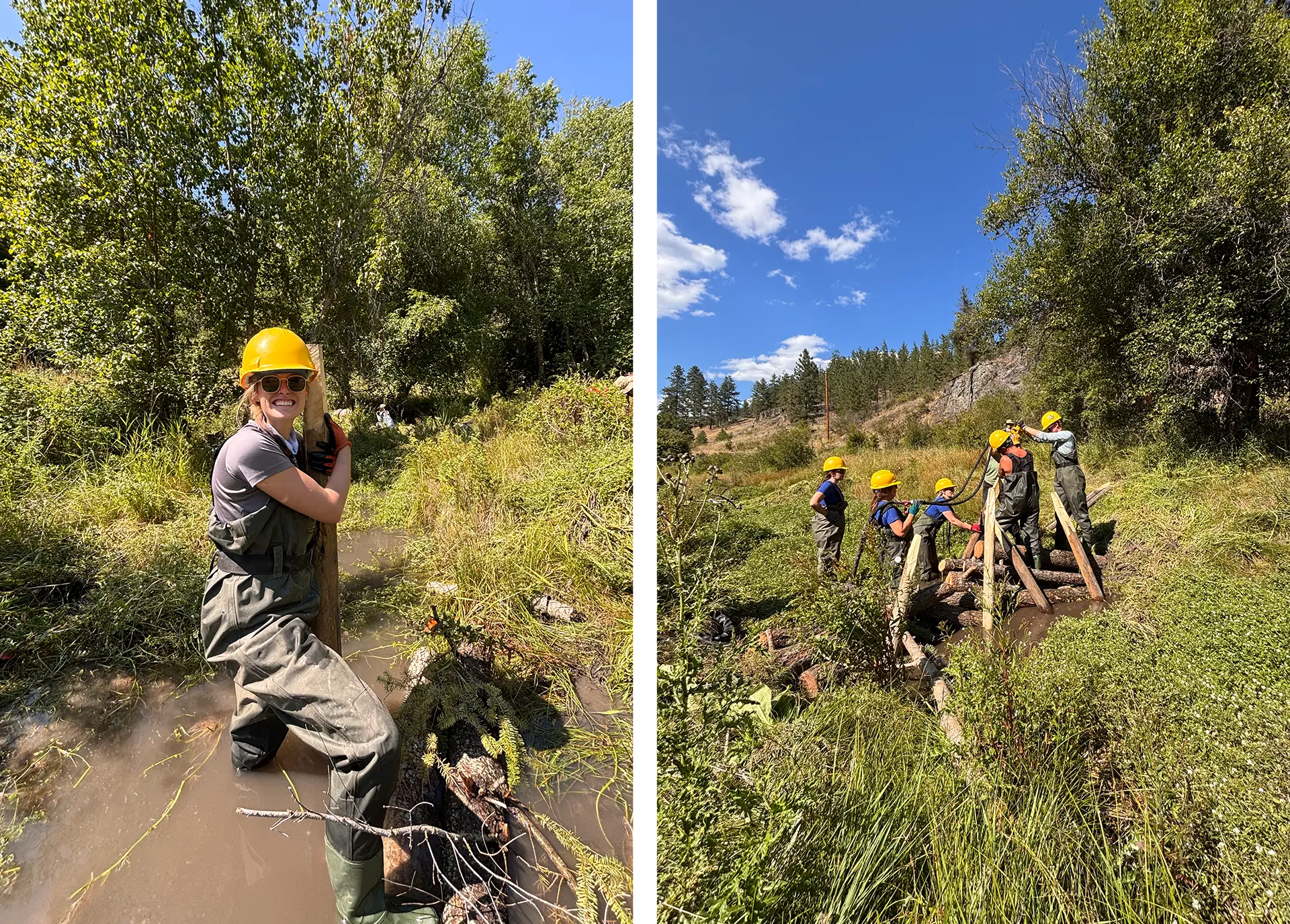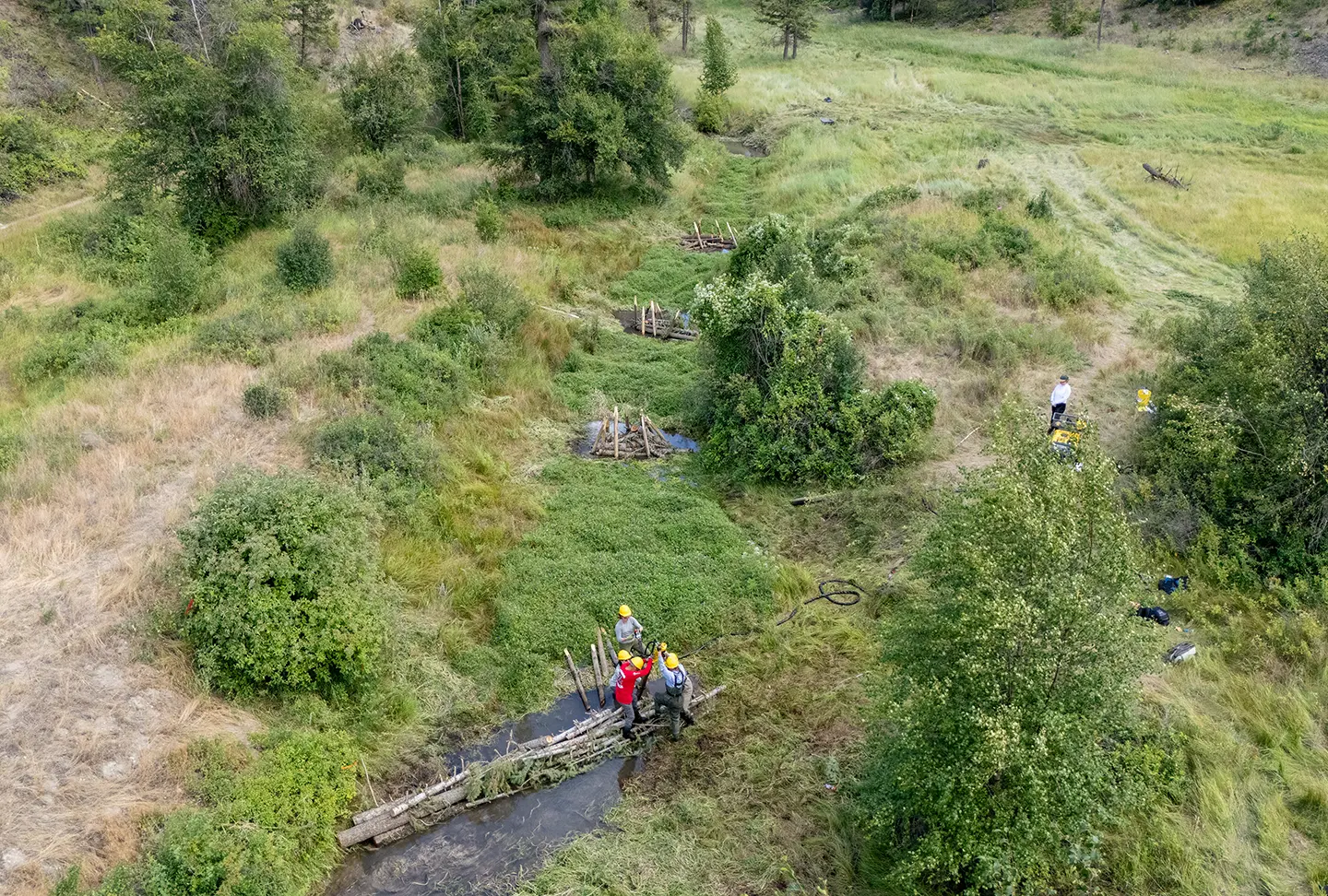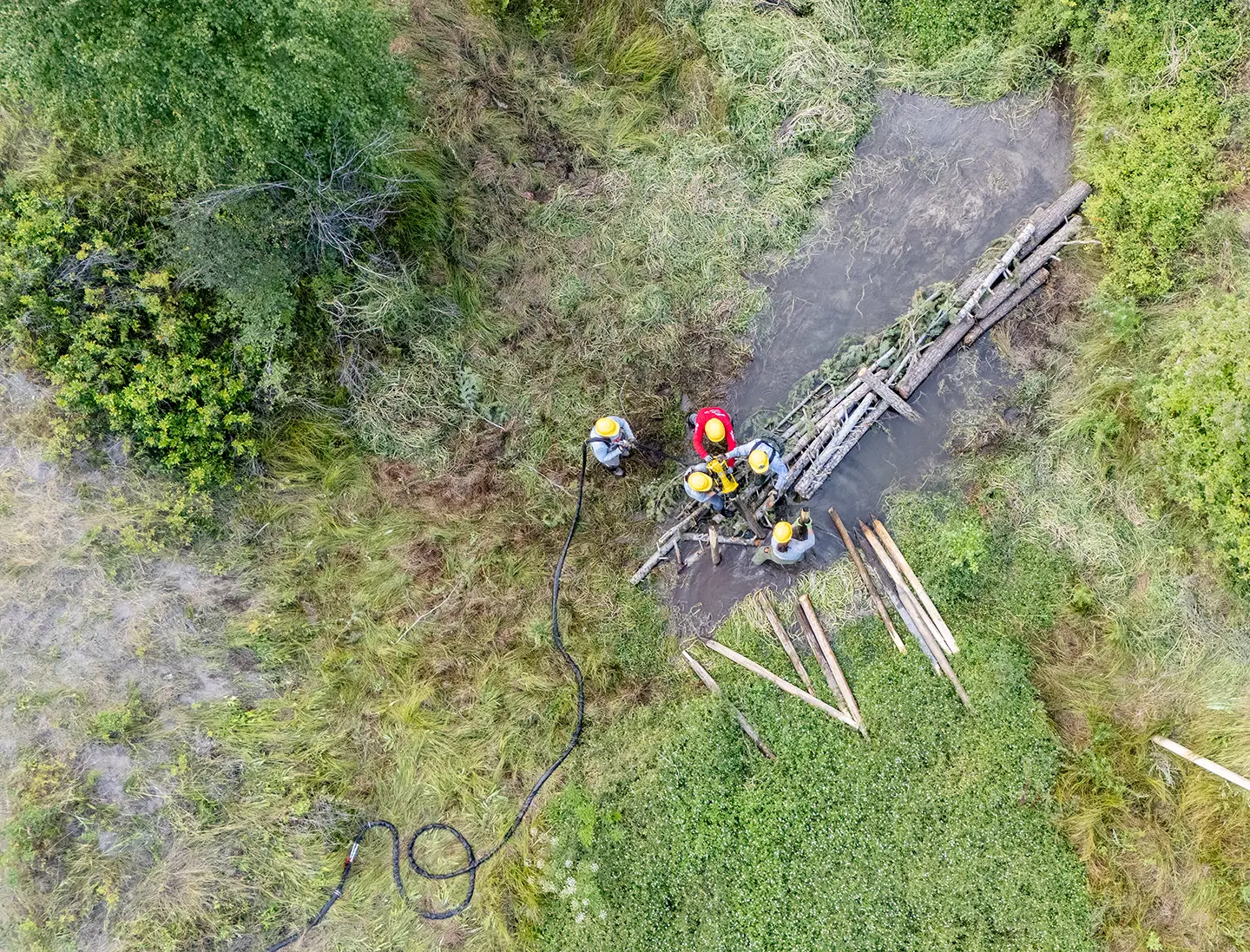Don’t underestimate the humble beaver. No animal has shaped North America’s landscape more than this industrious rodent. Before being hunted to the edge of extinction during the fur trade, beavers thrived across the continent, felling trees and creating dams that balanced ecosystems. That pursuit of beaver pelts carved out westward settlements that would form the basis of Canada. Now, despite its long reputation as an odd-looking and destructive pest, the beaver just may be the key to conservation thanks to its engineering prowess.
Yves Saint Laurent Beauty has partnered with The Nature Trust of British Columbia and the B.C. Wildlife Federation to enhance biodiversity in the Okanagan by creating human-made beaver dams and structures to mimic a beaver’s ecological impact on the land—and ideally, lure some actual beavers to populate the area.

Building a beaver dam analog. Photo by Jamie Long, B.C. Wildlife Federation.
The project is part of YSL Beauty’s larger Rewild Our Earth initiative managed in partnership with Re:wild, a global conservation nonprofit spearheaded by international scientists and environmentalist and actor Leonardo DiCaprio. The aim? To restore 100,000 hectares of land by 2030. They are halfway there: according to YSL’s international sustainability and scientific director, Caroline Nègre, YSL Beauty and Re:wild have, since 2017, worked together to restore 50,950 hectares of endangered ecosystems across eight biodiversity hot spots. These include projects in Morocco—where YSL sources botanicals used in its products—Indonesia, Haiti, and Madagascar. The initiative began in Morocco, Nègre explains, because of designer Yves Saint Laurent’s love for the country.
For the project’s Canadian launch in 2022, Re:wild turned to its local partner, The Nature Trust of BC, to help find an area that could benefit the most from the project’s biodiversity mandate. In addition to an extensive network of operational partners around the world, “we have a staff of very experienced conservationists and scientists who work on global committees that identify the most important places in the world for biodiversity,” Re:wild executive Carrie Hutchison says of the nonprofit’s wildlife restoration process.

Installing posts and using a hydraulic post-pounder. Photos by Rachel Brown, The Nature Trust of BC.
They settled on the small yet ecologically significant Park Rill Creek, a 160-acre parcel of land in the South Okanagan. “This area has a lot of grasslands, and that’s a really important ecosystem identified in the UN Decade on Ecosystem Restoration as critical,” Hutchison says. “A lot of times, rainforests and marine environments get most of the attention… but grasslands actually hold quite a bit of biodiversity. They’re very important to species not found anywhere else on Earth.”
The Park Rill Creek project will focus on a 1.5-kilometre stretch of the stream, which measures about five metres wide. It’s a small area but an important one, according to Jason Emery, the director of conservation land management at The Nature Trust. “That region sometimes gets referred to as a pocket desert,” he explains. “It gets really warm in the summer—warmer than most places in the province—and has relatively mild winters. And so as a result, we get a real high amount of diversity there.”
In the case of Park Rill Creek, The Nature Trust’s main conservation hurdle is erosion.
The region, made up of a mix of sagebrush steppe, grasslands, riparian zones, and broadleaf woodlands, is a critical habitat to “a disproportionately large number of species at risk” says Emery, who names the western tiger salamander, Lewis’s woodpecker, pallid bat, and western rattlesnake.
The Nature Trust bought Park Rill Creek in 2022, making it the latest slice of privately owned land purchased by the nonprofit within the encompassing White Pine Basin, an 8,222-hectare biodiversity hot spot. The Nature Trust’s mandate, according to Emery, is to acquire land for conservation purposes. “My team then takes care of those properties, essentially in perpetuity.”
In the case of Park Rill Creek, The Nature Trust’s main conservation hurdle is erosion. Trampled vegetation and soil from livestock along with possibly logging and mineral exploration in previous decades degraded the creek system, Emery says. In 2018, a heavy flood from snow melt destroyed vegetation along the creek and deepened the stream by carving steep banks on either side of it, taking away essential habitat for riparian species (plants or animals that live in the transition zone between land and water).
The solution may be in nature itself: beavers. “For a lot of years, especially in urban centres, you’d trap beavers and get rid of them because they cause problems,” Emery says. “They’re blocking streams, resulting in flooding.” And while that may be a nuisance for landowners and farmers, it’s essential for biodiversity by creating wetlands that foster riparian species.

Pounding posts in post-assisted log structures. Photo by Jamie Long, B.C. Wildlife Federation.
Beavers are a keystone species, defined as any organism that keeps its ecosystem together. Their chaotic and urgent need to build provides a greater impact. Their dams have been proven to reduce water pollution by filtering sediments, reduce downstream flooding, and create new ecosystems for fish and amphibians, as well as promote wildfire resiliency in riparian vegetation. Some researchers have found that beaver dams can sequester carbon, estimating that global beaver dams store up to 470,000 tons of carbon a year.
There are no beavers in Park Rill Creek, but the project will implement human-made beaver structures to create the same ecological effect.
For years, the B.C. Wildlife Federation has been building beaver dam analogs (BDAs) across the province’s watersheds. These are human-made beaver dams, built with organic materials such as wooden stakes, debris, mud, clay, grasses, and small branches. “They are in place to start slowing the water down, controlling the flow,” Emery explains. As well as reducing erosion, the BDAs also catch debris such as small sticks and pieces of wood that can then create deeper pools of water to serve as a cover for fish species who need it—trout after they’ve spawned, for example. “You’re essentially constructing what mimics a naturally occurring beaver dam on a smaller scale.”
After spending more than a year surveying and researching Park Rill Creek, as well as commissioning a study by Cabin Resource Management and the Penticton Indian Band (SnPink’tn) to evaluate areas of archaeological sensitivity on the land, in July The Nature Trust and the B.C. Wildlife Federation built 12 BDAs and eight post-assisted log structures (PALs). These are several wooden posts that are driven vertically about a metre deep into a stream to catch large logs flowing downstream, which then deflect water away from areas being impacted by erosion.
Emery’s team at The Nature Trust, along with Re:wild, will spend the next few years monitoring the results. He’s confident that the structures will create a more complex and healthy creek system, but what he really wants is for real beavers to step in and do the job for him.
The BDAs and PALs are “going to contribute to some better vegetation along the system, cooler water temperatures, better habitat for fish and amphibians,” Emery says. “For me personally, the gold medal would be if we actually had beavers show on the system. In that, you’ve automatically got a conservation partner that works 24/7 and never complains and does great stuff.”
In the past, BDAs have been proven to attract real beavers, he adds. For example, in 2014, 10 BDAs were built across five streams in the Scott River Basin in California—real beavers were found at all BDAs within the next four years. “Running water, or water that sounds like it’s constrained or is pushing through something, really attracts beavers. They want to fix it. It’s their natural thing. They want to dam it up,” he says. “That’ll be part of the monitoring that goes on after. It would be interesting to see what potentially happens. Do we actually get some beavers showing up here at some point?”
It may take a number of years, Emery concedes, but he’s crossing his fingers—especially since there are beavers in the surrounding area already, and they’ve been known to roam in search for water sources.
“If a beaver shows up, I think we’re all going to be doing a happy dance for that.”
Read more from our Autumn 2025 issue.









